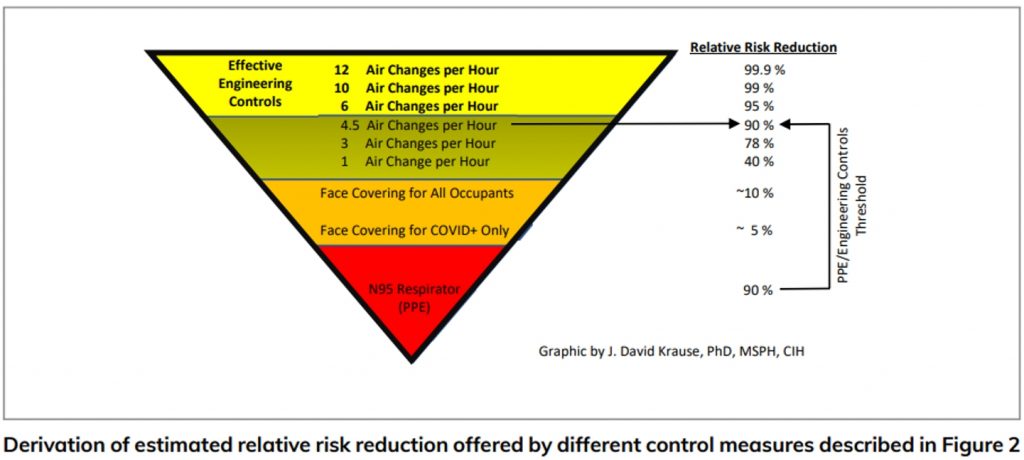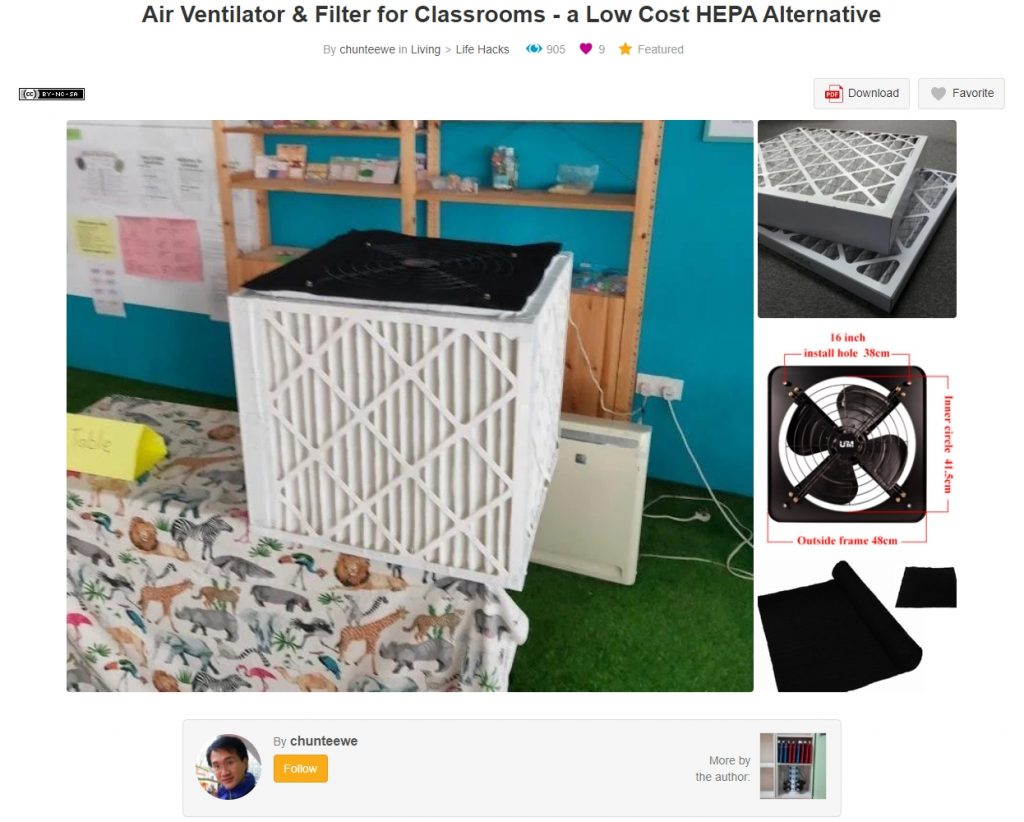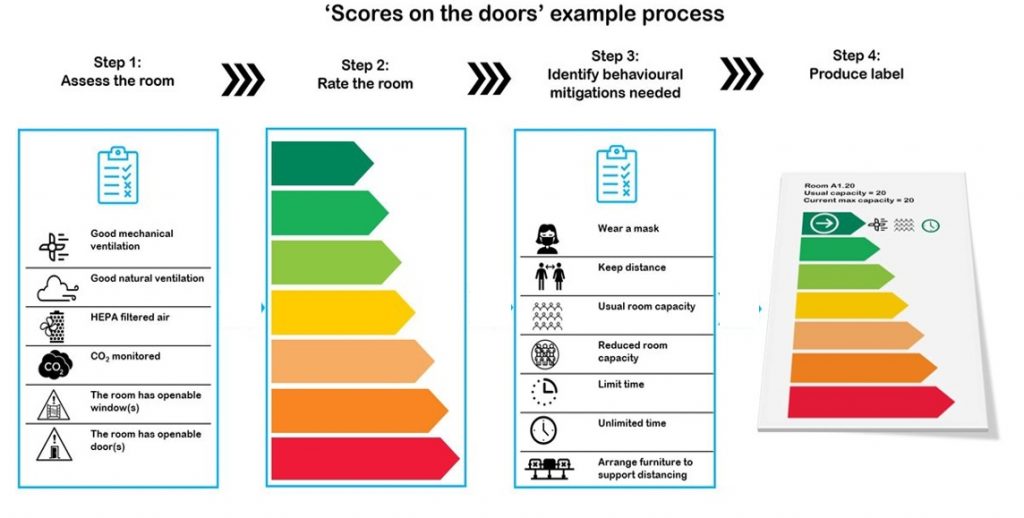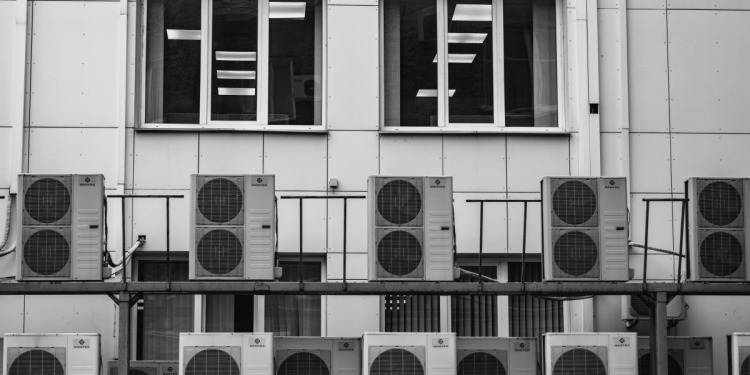As we work towards getting some normality back in our nation, we need to use every bit of evidence to minimise COVID-19 impact (especially with the huge breakthrough in vaccinated persons due to the Delta variant). One key missing element in Malaysia is optimising ventilation indoor.
In the early part of the pandemic the available data suggested surface decontamination was important. We now know that the COVID-19 virus is primarily spread by airborne mechanisms (aerosols), especially indoors.
Tiny suspended particles can remain airborne for hours and are recognised as an important route of transmission. Keeping a 1-2 meters distance in a room is of little value unless you improve ventilation (see systematic review). This means encouraging fresh air to come in all the time, stopping recirculation of air by air-conditioning units and cleaning the air of viral particles.
Remember that even if you practise these measures that you still need to maintain vigilance indoors:
- Avoid overcrowding of rooms and air spaces (cubicles, lifts, pantry, etc).
- Wear a good quality fit & filtration mask indoors all the time (avoid eating together).
- Limit your social interactions in other areas (maintain your safety bubble) and make use of RTK-Ag tests when necessary.
There are 3 main mechanisms for Reducing Airborne Transmission Indoors:
(we can mix the solutions to optimise indoor clean air)
A. Ventilation – Bring in Fresh Air
B. Filtration – Reduce Viral Particles in Air
C. Sterilisation – Sterilise the Air
A. Ventilation: Bring in Fresh Air
This is the best approach and works by diluting the airborne particles as well as bringing in fresh air.
The target is to get fresh air exchange 5-6x/hour/room (Harvard) or 10 L/s per person (DOSH).

Mechanisms to achieve fresh air exchange include:
- Keep windows and doors open to optimise natural ventilation. The flow of air in and out may vary with a breeze and time of day.
- Stop recirculation of air by air-conditioning or use HEPA filters in the air-conditioning system (not all air-conditioning systems can install these and it will reduce the capacity of the system while increasing the energy required to run them). Split air-conditioning units recirculate air; central units can bring in fresh air. (Installing UVC devices for central air-conditioning units requires safety with their use – see section C).
- Use mechanical ventilation to improve air exchange: Have a stand fan at the window to suck air out of or into the room or use window-mounted exhaust fans. Window-mounted exhaust fans can have MERV 13+ or HEPA filters to bring in clean air; useful for ground level rooms.
- Avoid any cross-drafts in the room created by fans – will blow aerosols from one person to another.
- Use reliable Carbon dioxide (CO2) monitors as a proxy indicator of airborne particles (poor ventilation) – there are fake products on the market and the reference offers a detailed review. Keep C02 levels < 600ppm or at least below 800ppm. Testing should be done without persons in the room & then with expected numbers of people. Best to monitor CO2 continually during a meeting/room use so as to adjust ventilation accordingly.
- Plastic physical barriers between seats and spaces are no longer routinely recommended as data suggest that they do not stop aerosol particles from spreading and hinder ventilation and air flow.
- Keep toilet exhaust fans on.
Which Portable CO2 monitor to buy?
A good review of CO2 monitors suggests that Aranet4 detectors are one of the best and very accurate but expensive (RM 1,000+) – private hospitals & large businesses should invest in these.
There are also expensive wired monitors that not only measure CO2 but also measure PM 2.5 (particulate material) throughout the day and offer alarms.
B. Filtration: Reduce Viral Particles in the Air
This is a reasonably effective mechanism if good units are used. A Portable Air Cleaner with good filters (HEPA filters or MERVS filters > 13/14) is used to suck in air, trapping viral particles and releasing clean air. The target again is to get air exchange of 5-6x/hour/room (Harvard) or 10 L/s per person (DOSH).
Useful in rooms without outdoor connections and air conditioning (recirculating air) is still on.

Some issues that need to be considered:
- Portable Air Cleaners come in a wide range of capacity and cost. There may also be fakes on the market. It is best to buy a reliable device (see review) or make a good home made kit (see below on the Corsi cube).
- The University of Melbourne has done a review of which air cleaners work best in relation to their cost (see image & link).
- Devices should have a minimum MERV filter (Minimum Efficiency Reporting Value filter) of 13/14 or use HEPA filters (High Efficiency Particulate Air filter – all HEPA filters are MERV 17 or higher) .
- The capacity of the devices must match the room volume/size. Check their CADR (clean air delivery rates).
- Use the Harvard – CU Boulder Portable Air Cleaner Calculator to work out room needs.
You may need more than one device per room if speed is important – see good Australian hospital study : “With 2 small domestic air cleaners in a single patient room of a hospital ward, 99% of aerosols could be cleared within 5.5 minutes”. - For meetings or consultations, the device is best kept near persons who are meeting rather than in the corner of the room.
- The filters will need to be changed periodically (check with the manufacturer) and it is important to factor in the cost of filter replacements.
- Some units have high noise levels – check the manufacturer’s statement/specifications on this. You may need to use the devices at lower speeds to deal with noise which will reduce the CADR (clean air delivery rates).
- Avoid units that blow air out horizontally – create a draft (aerosol spread from person to person). Prefer units that blow upwards.
- Note that Carbon dioxide (CO2) monitors will not work with this method in a closed room as air in the room is not being exchanged, only filtered.
- Use of HEPA filters in existing air-conditioning units (especially central units) may be possible. But not all air-conditioning systems can install these and it will reduce the capacity of the system while increasing the energy required to run them. UVC devices for central air-conditioning units require safety with their use and cannot be used alone – see section C below.
DIY Portable Air Cleaner/Filtration
Corsi Cube (Corsi-Rosenthal Cube)
Named after environmental engineer Richard Corsi of Portland State University in Oregon, consist of cubes made of 4 or 5 MERV filters with a box fan as the sixth side (some people use 4 filters and a cardboard sheet at the base so as to blow air upwards). An inexpensive and effective air filter that can be used in a classroom or clinic to filter aerosols out of indoor air. This design can move 25 cubic meters of air per minute. Corsi Cube filters probably last 6 months.
You can also view related articles here, here and here.
Local Corsi Cube Instructions

One of our local engineers has been making the Corsi Cube for schools. The cost can be kept below RM 300-400.
C. Sterilisation: Sterilise the Air

There has been increasing interest to use ultraviolet irradiation technology to disinfect indoor air – Ultraviolet germicidal irradiation (UVGI). UVGI is either centralized (used within the central air-conditioning unit, or ducts) or deployed as an ‘upper room’ device. Upper-room ultraviolet germicidal air disinfection has been used largely in tuberculosis with good literature/data.
Two recent reviews on the potential use of such devices in COVID-19 stated “Ultra-Violet Germicidal Irradiation (UVGI) lack of quality data from experiments” and “UV technologies should not be utilized in isolation and should be considered as an adjunct” .
See also FDA on ultraviolet-C radiation use for disinfection, Coronavirus, and IES Committee Report on Germicidal Ultraviolet (GUV). Upper-room GUV (254 nm) systems may be useful. And this article reviewing ventilation options suggests that upper-room UVGI may have a place but requires more data.
There are many other sterilising options out there and the University of Melbourne review on air cleaners stated regarding ioniser/plasma/ozone/photocatalytic oxidation/precipitators “These are unproven/untested technologies, and in some cases actually dangerous technologies, significantly degrading the air quality by producing ions, ozone and oxidation products. Ozone and ions can also trigger asthma, so these technologies should be avoided”.
A Simple Guide to Operationalizing the Data – Optimising Indoor Ventilation
(Reducing Airborne Transmission Indoors)
These are just my suggestions after all my reading. Most guides use complex methods that are possibly beyond the use of the average person.
Method 1: Calculation Method
Target: Air exchange 6x/hour/room
- Step 1: Calculate room volume – Length x Width x Height
Example a room of 12 x 6 x 3 meters = 216 meter3
- Step 2: Determine air exchange required – Multiply by 6 air exchange per hr
Example: 216 meter3 x 6 = 1,296 meter3 per hour
- Step 3: If no capability to measure fresh coming in (or in a closed room) then use Portable Air Cleaners – check their CADR (clean air deliver rates) but at low noise levels
Example: Require 2-3 units of a Xiaomi Mi Air Purifier Pro (RM 2-3,000) or 2 units of a 4 filter Corsi Cube (~RM800)
- Step 4: Keep monitoring CO2 levels & keep < 800ppm (ideal < 600ppm)
Method 2: CO2 Monitoring Method
Target: Keep CO2 levels < 800ppm (ideal < 600ppm)
- Step 1: Get a reliable CO2 monitor and watch levels in the room over time, with the number of persons & activities & ventilation methods used.
- Step 2: Optimise outdoor fresh air coming in – open doors & windows. Check CO2 levels.
- Step 3: If insufficient or not possible (closed room) then use mechanical ventilation to improve air exchange (exhaust fans or inlet fans with filters). Check CO2 levels.
- Step 4: If CO2 is still high then add Portable Air Cleaners.
- Optimise until CO2 target is reached throughout the day (especially at peak usage).
Improving Ventilation: A Way of Life Post COVID
COVID-19 will not be the last airborne viral pandemic. In addition, we have learnt these past 2 years the importance of indoor ventilation to reduce CO2 as well as other viral and bacterial pathogens. It is important that we put in place permanent measures to ‘fix’ indoor ventilation, monitor it and communicate/certify building safety. This requires an assessment of all indoor spaces, taking measures to improve it, as well as appointing staff to be responsible to monitor indoor air quality. We need our engineers to help us do this. The Independent Scientific Advisory Group for Emergencies (SAGE) has come out with a ‘Covid Scores on the Doors’: An Approach to Ventilation/Fresh Air Information, Communication, and Certification. The aim is to inform the public about the ventilation quality in any room/shop/building so they can take the necessary action/protection (see image below).

You can view Dr Amar Singh’s talk on “Improving Indoor Ventilation” with DOBBS below:
This opinion piece was contributed by Dato’ Dr Amar-Singh HSS, Senior Consultant Paediatrician. If you have an article or opinion that you would like to contribute for the benefit everyone, share it with us here.
[ IMAGE SOURCE ]








